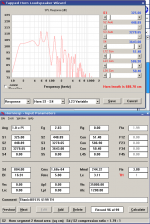Not sure how the double post happened, please delete
Warning this is rather long and detailed. The meat of my questions is listed after the Bold text below.
As part of a church virtual organ project I am looking at sub options. Requirements include high output (and clean, don't want a Bourdon sounding like a Contra Bassoon) down to 16Hz firing into 50,000+ cubic feet.
Of course I looked at standard ported enclosures as well as Transmission Lines (standard and reverse taper). Although the TLs look like a nice compromise in size and output, it would probably require at least 4 15" long throw cabs and the modeling indicates that wild swings in output might be a problem as low as 40Hz making the low end requirements on the mains a bit stiff. It may well be that the model is worse than the reality after stuffing, but it got me thinking about using front loaded horns.
The speakers will be in chambers high up on both sides of the platform. Each chamber is large enough to hold three compact cars stacked on top of each other. The openings are about 6 feet wide by 7 feet tall.
I remembered reading about the Labhorns. Knowing that they are designed for much higher cut off, but also knowing that their low fs should support much lower frequency operation I set about modeling in Hornresp.
Of course the ideal horn has a mouth of about 90,000 cm^2 which is a bit ungainly. The flat response with max output of around 130dB using a single Lab12 driver is rather attractive though 😉. So then I looked at suboptimal versions and...
Here is the meat of the matter:
I started by cutting back the ideal horn to where the mouth area was 1/4 and 1/6 of ideal. Of course what I discovered is that the cut off frequency went up also along with the reduced output toward the lower end of the range and the increased ripple. I found that to get the same cut off I had to increase the length back almost (but not quite) to where I started. So...
1. When designing horns for stacking does one design for the same low end extension on the individual subs as on the ideal or does the stacking lower the cut off (including keeping the driver from unloading) of the system so that you can use the shorter horn length?
2. Does the interaction of the mouths reduce the ripple when stacked?
3. Would there be any advantage to making the horn path length slightly longer on one of the horns so that the peaks and troughs in the response counteract one another?
4. If the stacking does indeed lower the cut off frequency could one design the subs as ideal horns but at a higher cut off?
Please edumacate me here. 😉
Ideal Horn...
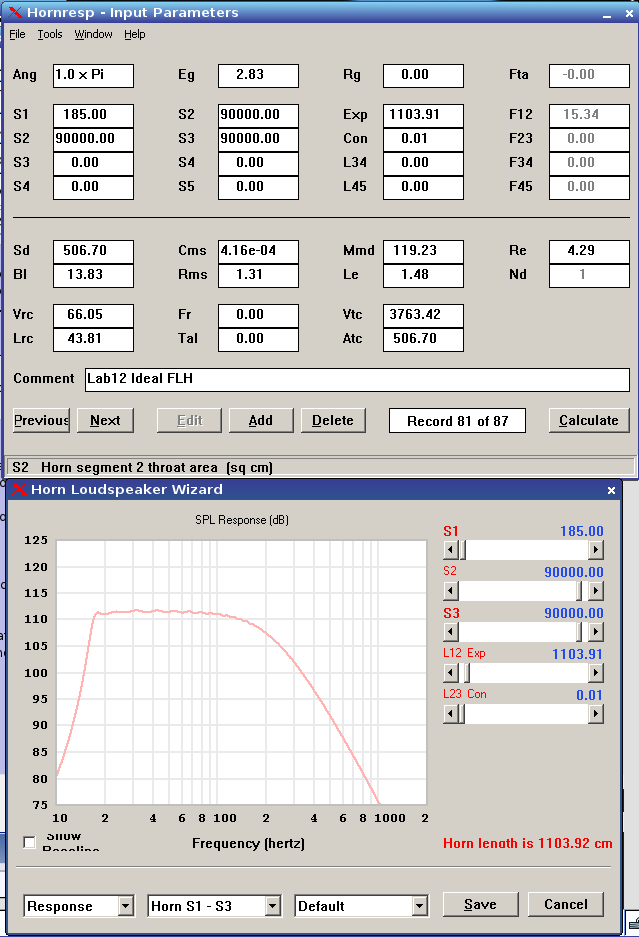
One Sixth size...
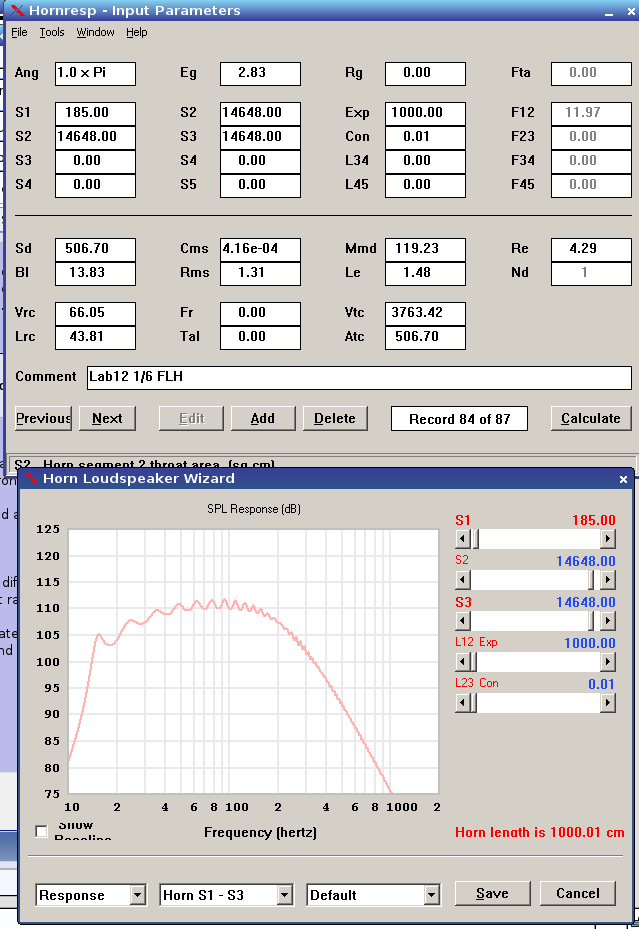
mike
Warning this is rather long and detailed. The meat of my questions is listed after the Bold text below.
As part of a church virtual organ project I am looking at sub options. Requirements include high output (and clean, don't want a Bourdon sounding like a Contra Bassoon) down to 16Hz firing into 50,000+ cubic feet.
Of course I looked at standard ported enclosures as well as Transmission Lines (standard and reverse taper). Although the TLs look like a nice compromise in size and output, it would probably require at least 4 15" long throw cabs and the modeling indicates that wild swings in output might be a problem as low as 40Hz making the low end requirements on the mains a bit stiff. It may well be that the model is worse than the reality after stuffing, but it got me thinking about using front loaded horns.
The speakers will be in chambers high up on both sides of the platform. Each chamber is large enough to hold three compact cars stacked on top of each other. The openings are about 6 feet wide by 7 feet tall.
I remembered reading about the Labhorns. Knowing that they are designed for much higher cut off, but also knowing that their low fs should support much lower frequency operation I set about modeling in Hornresp.
Of course the ideal horn has a mouth of about 90,000 cm^2 which is a bit ungainly. The flat response with max output of around 130dB using a single Lab12 driver is rather attractive though 😉. So then I looked at suboptimal versions and...
Here is the meat of the matter:
I started by cutting back the ideal horn to where the mouth area was 1/4 and 1/6 of ideal. Of course what I discovered is that the cut off frequency went up also along with the reduced output toward the lower end of the range and the increased ripple. I found that to get the same cut off I had to increase the length back almost (but not quite) to where I started. So...
1. When designing horns for stacking does one design for the same low end extension on the individual subs as on the ideal or does the stacking lower the cut off (including keeping the driver from unloading) of the system so that you can use the shorter horn length?
2. Does the interaction of the mouths reduce the ripple when stacked?
3. Would there be any advantage to making the horn path length slightly longer on one of the horns so that the peaks and troughs in the response counteract one another?
4. If the stacking does indeed lower the cut off frequency could one design the subs as ideal horns but at a higher cut off?
Please edumacate me here. 😉
Ideal Horn...
One Sixth size...
mike
Last edited:
The answer to 1, 2 and 4 is: Use the "multiple speakers" option in Hornresp to find out.
The answer to 3 is: Don't do that.
To add a bit to that, yes, multiple stacked horns will play a bit deeper, but not much. Yes, multiple stacked horns will clean up the ripple. But the ripple you have shown here is really inconsequential, it's less than 2 db peak to peak, in other words don't worry about it, you won't hear it.
Also remember that if the building is relatively solid there will be some pressure (room) gain, so you probably don't need it ruler flat down to tuning.
And also look into direct radiator options as well. The price of very large, low fs drivers is coming down fast these days, so consider your options carefully, especially if you don't completely understand how to design and fold horns.
Stereo Integrity | HT Subwoofers
That's $162 each (preorder price, $190 regular price) for an 18 with 22 mm xmax. And next year some small company is going to come along and beat that with an even better deal. I like horns but sometimes simple is better.
The answer to 3 is: Don't do that.
To add a bit to that, yes, multiple stacked horns will play a bit deeper, but not much. Yes, multiple stacked horns will clean up the ripple. But the ripple you have shown here is really inconsequential, it's less than 2 db peak to peak, in other words don't worry about it, you won't hear it.
Also remember that if the building is relatively solid there will be some pressure (room) gain, so you probably don't need it ruler flat down to tuning.
And also look into direct radiator options as well. The price of very large, low fs drivers is coming down fast these days, so consider your options carefully, especially if you don't completely understand how to design and fold horns.
Stereo Integrity | HT Subwoofers
That's $162 each (preorder price, $190 regular price) for an 18 with 22 mm xmax. And next year some small company is going to come along and beat that with an even better deal. I like horns but sometimes simple is better.
Last edited:
Thanks for your reply. That Stereo Integrity looks very interesting. A quick TL sim (which is a direct radiator after all) looks pretty nice. My main concern with using a new company is concerns about long term reliability and viability for a church installation. My gut says established folks like Eminence and Dayton have an advantage there.
If, as I suspect, the first resonance wiggle on a TL can be well damped with stuffing then use up to 60 to 80Hz should be no problem. Looks like over 120dB at 16Hz is possible with a single cabinet (using insane amounts of power) and the 130dB target is easily reached with four cabinets. Ported looks fine also. Infinite baffle would require at least 8 drivers to reach the target output along with 12dB/8va boost under 80Hz.
A few passes with the multiple speakers tool on the horns seems to indicate just an increase in output but I wonder whether that feature really models the mouth interactions. Cost no object I really like the mongo horns but I suspect you are right about the practical approach.
If, as I suspect, the first resonance wiggle on a TL can be well damped with stuffing then use up to 60 to 80Hz should be no problem. Looks like over 120dB at 16Hz is possible with a single cabinet (using insane amounts of power) and the 130dB target is easily reached with four cabinets. Ported looks fine also. Infinite baffle would require at least 8 drivers to reach the target output along with 12dB/8va boost under 80Hz.
A few passes with the multiple speakers tool on the horns seems to indicate just an increase in output but I wonder whether that feature really models the mouth interactions. Cost no object I really like the mongo horns but I suspect you are right about the practical approach.
As part of a church virtual organ project I am looking at sub options. Requirements include high output (and clean, don't want a Bourdon sounding like a Contra Bassoon) down to 16Hz firing into 50,000+ cubic feet.
Mike,
Just one of Josh Ricci's "Gjallerhorn" can approach the level you want, it can do 124.2 dB at one meter at 20 Hz outdoors.
http://www.diyaudio.com/forums/subwoofers/189784-gjallerhorn.html
Josh has done extensive testing, the Gjallerhorn is the real deal.
He also has tested many "bottom feeders", results are on his DataBass website.
Yes those THs look pretty capable and have a relatively small footprint. Of course they have even more trouble with wild swings in the high range than the TLs. A stack of two such THs would be more than adequate I think.
If your pockets are deep enough to afford a couple of Gjallerhorns, you might look into some of Danley's products as well. Sometimes they offer the DTS 10 in kit form. There are options available, if you can afford them.
Mike,Yes those THs look pretty capable and have a relatively small footprint. Of course they have even more trouble with wild swings in the high range than the TLs. A stack of two such THs would be more than adequate I think.
Multiple TH or FLH cabinets smooth frequency response, and room modes are generally more a problem than cabinet FR.
At any rate, to integrate long horns to the main cabinets requires DSP, and even the most basic DSP have PEQ which can correct the FR variations horn cabinets generally exhibit.
Art
Very shallow pockets here actually. 😉 Very much appreciate all of the ideas here. As to integrating horns I do have the advantage that the "main" speakers are already going to be about 8 to 10 feet further back into the chambers than the mouth of any bass horn used in order to take advantage of the acoustics of the "pipe" chambers. Initially due to cost I will need will be limited to two to four channels per chamber for the mains. Ideally of course one would want to have no more than two or three ranks per channel.
I will probably start by experimenting with some organ drivers that I have on hand once I measure the parameters. That way I can get a better idea of what the actual requirements are.
I will probably start by experimenting with some organ drivers that I have on hand once I measure the parameters. That way I can get a better idea of what the actual requirements are.
Some of the software does allow one to adjust the individual pipes (Grandorgue and Hauptwerk for example). It is a bit more difficult if your are using jOrgan with fluidsynth. I have come up with several plausible options using TLs, BLHs, and THs so there are a lot of things to try.
Oddly enough the Dayton 15" IB driver looks very nice in a TL or BLH. The Qts of the current version is only 0.59 IIRC so it really is better with a little bit of help from the back wave unless used in a smaller room. The Lab12 looks very good in a small TH. The Lab15 seems to want a pretty high compression ratio for TH so I am thinking that that it would be better in one of the other cabinet types. The Stereo Integrity looks good in TL and BLH as well. The Titankic 15 has some possibilities but I am not sure how it would hold up in a TH.
Oddly enough the Dayton 15" IB driver looks very nice in a TL or BLH. The Qts of the current version is only 0.59 IIRC so it really is better with a little bit of help from the back wave unless used in a smaller room. The Lab12 looks very good in a small TH. The Lab15 seems to want a pretty high compression ratio for TH so I am thinking that that it would be better in one of the other cabinet types. The Stereo Integrity looks good in TL and BLH as well. The Titankic 15 has some possibilities but I am not sure how it would hold up in a TH.
Are you buying amps or using whatever is already there? If you have to work with existing amps that will narrow down your driver choices a bit.
Hi,
Played with an earlier suggested driver...
Did you test simulating ' Organ-subs' like a T-TQWT or a T-QWP's that in the reality really can pass a 16'stopped pipe tone whitout adding 'Horn' sounding 'strained' due to the work with a a very high compression'?
b 🙂
Played with an earlier suggested driver...
Did you test simulating ' Organ-subs' like a T-TQWT or a T-QWP's that in the reality really can pass a 16'stopped pipe tone whitout adding 'Horn' sounding 'strained' due to the work with a a very high compression'?
b 🙂
Attachments
Not sure I understand your question. e.g.
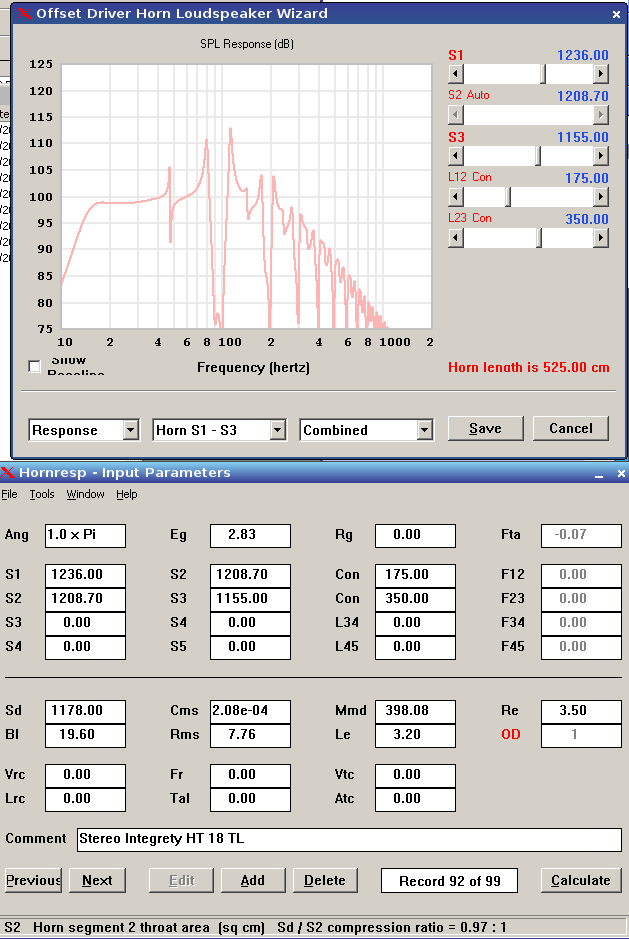
The Stereo Integrity seemed to prefer a straight pipe. I didn't do TH for the Stereo Integrity but I did for Lab12 and Titanic 15. They did have some compression but not a huge amount.
Lab12...
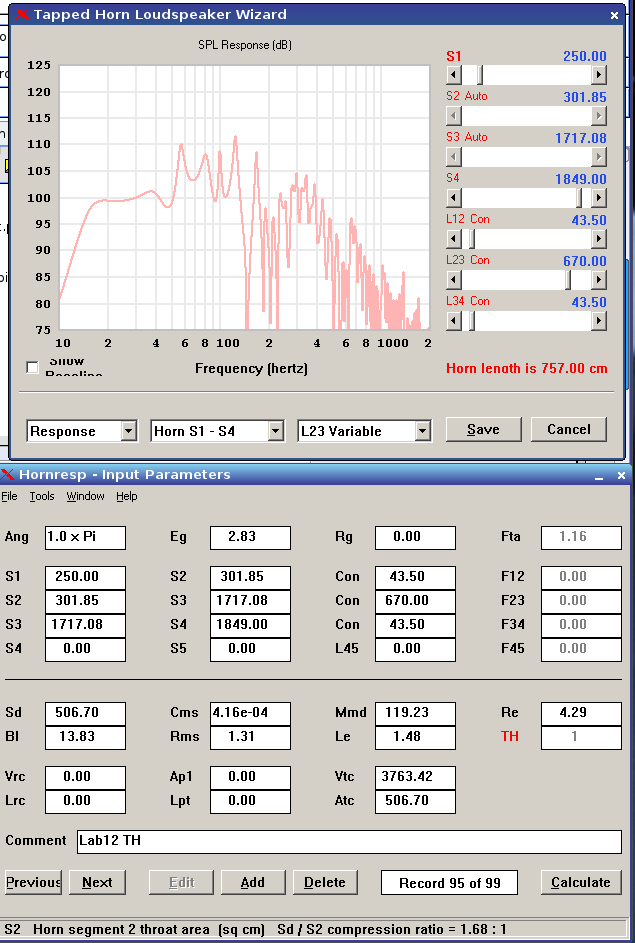
Titanic...
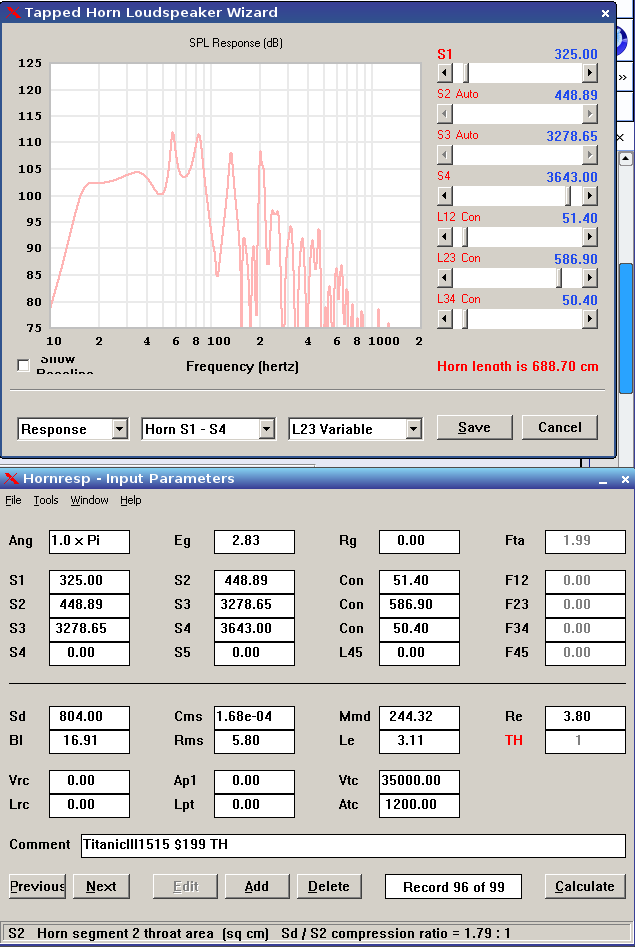
The Stereo Integrity seemed to prefer a straight pipe. I didn't do TH for the Stereo Integrity but I did for Lab12 and Titanic 15. They did have some compression but not a huge amount.
Lab12...
Titanic...
Attachments
At first I didn't get what you meant by T-TQWT. By the light of day I think I see that it is simple a TH with decreasing tapper rather than expanding horn. I can see that it should give a little bit better bandwidth (at the expense of a little bit of output) and probably be easier on the driver physically. I will run some sims when I get a chance and report back.
Thanks again for all the helpful input.
Thanks again for all the helpful input.
Just realized that I forgot to answer justaguy's question. Virtually everything including amplification will be new. We have a couple of 200WPC mixer amps that may be pressed into service for some of it but basically we are starting from scratch. I doubt that we will be spending the kilo-bucks necessary for multiple kilowatt per channel amps so IB is probably out of the question and reasonable efficiency would be a goal.
q4u:
If "almost all" real organs do the 'missing fundamental' thing, and don't really have 64' ranks... why would you need 16hz?
Does your virtual organ patch do a real C0, or does it beat together two tones for a missing fundamental? (hauptwerk?)
Double check before you design your pedal section.
If "almost all" real organs do the 'missing fundamental' thing, and don't really have 64' ranks... why would you need 16hz?
Does your virtual organ patch do a real C0, or does it beat together two tones for a missing fundamental? (hauptwerk?)
Double check before you design your pedal section.
Last edited:
32' rank is 16Hz, 64 would be 8Hz. Several dispositions do have 32' flutes or diapasons which will have a pretty good fundamental.
I doubt that we will be spending the kilo-bucks necessary for multiple kilowatt per channel amps...
It's not just drivers that are dropping dramatically in price these days.
Aliexpress.com : Buy fp14000 digital power amplifiers from Reliable professional amplifier suppliers on Guangzhou Sanway Audio Factory
A bit less than 1 kilo-buck will get you 14000 watts rms if you don't mind dealing directly with China (and the problems that can come from that).
Have you checked the resonance frequency of any walls, ceiling and floor?
As well as any pillars/supports?
Many organs not using 16Hz is probably not because they couldn't but because they shouldn't. Structural damage put the end to any 8Hz organ built.
I would not buy the amp above. Designing an amp with that amount of power takes a bit more effort than point and clone. Or they could have improved quality over LABgruppen, they certainly have higher power specifications.
As well as any pillars/supports?
Many organs not using 16Hz is probably not because they couldn't but because they shouldn't. Structural damage put the end to any 8Hz organ built.
I would not buy the amp above. Designing an amp with that amount of power takes a bit more effort than point and clone. Or they could have improved quality over LABgruppen, they certainly have higher power specifications.
I would not buy the amp above. Designing an amp with that amount of power takes a bit more effort than point and clone. Or they could have improved quality over LABgruppen, they certainly have higher power specifications.
These amps are famous for having issues, but the issues are more along the lines of quality control and packaging, not engineering. But even so, there's a whole community of people that are extremely happy with them, even people that received them DOA due to improper voltage setup (fixed by adjusting a variable resistor) and people who received them slightly smashed due to improper packaging. Being able to overlook issues like that and still be a happy customer is a pretty strong endorsement.
Lab Gruppen FP14000 clone amplifiers
If you don't like the risk and prefer to have a middleman between yourself and China, the Behringer EP4000 is available for around $300 from WalMart.
The point here is that power is not expensive anymore, especially if you live in the USA.
- Status
- Not open for further replies.
- Home
- Loudspeakers
- Subwoofers
- Virtual Organ Stacked Horn Sub Questions



